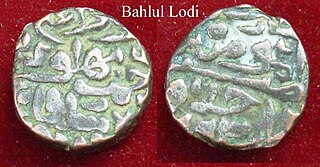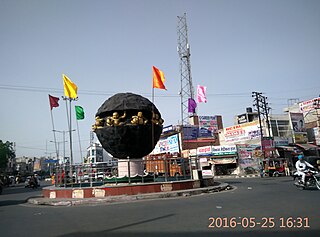
The Delhi Sultanate or the Sultanate of Delhi was an Islamic late medieval empire primarily based in Delhi that stretched over large parts of the Indian subcontinent, for 320 years (1206–1526). Following the invasion of South Asia by the Ghurid dynasty, five dynasties ruled over the Delhi Sultanate sequentially: the Mamluk dynasty (1206–1290), the Khalji dynasty (1290–1320), the Tughlaq dynasty (1320–1414), the Sayyid dynasty (1414–1451), and the Lodi dynasty (1451–1526). It covered large swaths of territory in modern-day India, Pakistan, and Bangladesh as well as some parts of southern Nepal.

Sultan Firuz Shah Tughlaq was a Muslim ruler from the Tughlaq dynasty, who reigned over the Sultanate of Delhi from 1351 to 1388. He succeeded his cousin Muhammad bin Tughlaq following the latter's death at Thatta in Sindh, where Muhammad bin Tughlaq had gone in pursuit of Taghi the rebellious Muslim governor of Gujarat. For the first time in the history of the Sultanate, a situation was confronted wherein nobody was ready to accept the reins of power. With much difficulty, the camp followers convinced Firoz to accept the responsibility. In fact, Khwaja Jahan, the Wazir of Muhammad bin Tughlaq had placed a small boy on the throne claiming him to be the son of Muhammad bin Tughlaq, who meekly surrendered afterwards. Due to widespread unrest, his realm was much smaller than Muhammad's. Tughlaq was forced by rebellions to concede virtual independence to Bengal and other provinces. He established Sharia across his realm.
The Sayyid dynasty was the fourth dynasty of the Delhi Sultanate, with four rulers ruling from 1414 to 1451 for 37 years. The first ruler of the dynasty, Khizr Khan, who was the Timurid vassal of Multan, conquered Delhi in 1414, while the rulers proclaimed themselves the Sultans of the Delhi Sultanate under Mubarak Shah, which succeeded the Tughlaq dynasty and ruled the Sultanate until they were displaced by the Lodi dynasty in 1451.

Raziyyat-Ud-Dunya Wa Ud-Din, popularly known as Razia Sultana, was a ruler of the Delhi Sultanate in the northern part of the Indian subcontinent. She was the first female Muslim ruler of the subcontinent, and the only female Muslim ruler of Delhi.

Shams ud-Din Iltutmish was the third of the Mamluk kings who ruled the former Ghurid territories in northern India. He was the first Muslim sovereign to rule from Delhi, and is thus considered the effective founder of the Delhi Sultanate.
Sultana or sultanah is a female royal title, and the feminine form of the word sultan. This term has been officially used for female monarchs in some Islamic states, and historically it was also used for sultan's consorts.

The Mamluk dynasty, also known as Slave dynasty, was a dynasty which ruled Delhi Sultanate from 1206 to 1290. It was the first of five largely unrelated dynasties to rule the Delhi Sultanate until 1526. Before the establishment of the Mamluk dynasty, Qutb al-Din Aibak's tenure as a Ghurid dynasty administrator lasted from 1192 to 1206, a period during which he led forays into the Gangetic plain and established control over some of the new areas.

Bahlul Khan Lodi was the chief of the Afghan Lodi tribe. Founder of the Lodi dynasty from the Delhi Sultanate upon the abdication of the last claimant from the previous Sayyid rule. Bahlul became sultan of the dynasty on 19 April 1451.

The Khalji or Khilji dynasty was the second dynasty which ruled the Delhi sultanate, covering large parts of the Indian subcontinent for nearly three decades between 1290 and 1320. It was founded by Jalal ud din Firuz Khalji.

Kaithal is a city and municipal council in the Kaithal district of the Indian state of Haryana. Kaithal was previously a part of Karnal district and later, Kurukshetra district until 1 November 1989, when it became the headquarters of the Kaithal. It shares a border with the Patiala district of state Punjab and the Kurukshetra, Jind and Karnal districts of Haryana. Kaithal district is situated in the North-West of the Haryana state. Its North-West boundaries, which include Guhla-Cheeka are attached to Punjab.

Ghiyas ud din Balban was the ninth sultan of the Mamluk dynasty of Delhi.

Rukn-ud-din Firuz, also transliterated as Rukn al-Din Firoz, was a ruler of Delhi sultanate for less than seven months in 1236. As a prince, he had administered the Badaun and Lahore provinces of the Sultanate. He ascended the throne after the death of his father Iltutmish, a powerful Mamluk ruler who had established the Sultanate as the most powerful kingdom in northern India. However, Ruknuddin spent his time in pursuing pleasure, and left his mother Shah Turkan in control of the administration. The misadministration led to rebellions against Ruknuddin and his mother, both of whom were arrested and imprisoned. The nobles and the army subsequently appointed his half-sister Razia on the throne.

Muiz ud-Din Bahram was the sixth sultan of the Mamluk Dynasty.
Mercenaries in India were fighters, primarily peasants, who came from India and abroad, to fight for local rulers in India in the medieval period. This mercenary work became an important source of income for some communities.

Qila Mubarak, is a historical monument in the heart of the city of Bathinda in Punjab, India. It is recognized as monument of national importance and maintained by Archaeological Survey of India. It has been in existence from 1100 to 1200 AD in its current place and is the oldest surviving fort in India. It was here that Razia Sultan, the first woman to take charge of the Delhi throne was incarcerated upon her defeat and dethroned. The bricks of the fort date back to the Kushana period when emperor Kanishka ruled over Northern India/Bactria. Raja Dab, along with emperor Kanishka, is believed to have built the fort. Qila Mubarak in latter part of the 10th Century was under the rule of Jayapala, a ruler of the Hindu Shahi dynasty.
Jamal ud-Din Yaqut was an African Siddi slave-turned-nobleman who was a close confidant of Razia Sultana, the first and only female monarch of the Delhi Sultanate in India. Yakut was the puppet of Razia Sultan's stepmother but after sometime he became a trustworthy soldier of the Delhi Sultanate. Razia Sultana's patronage made him an influential member of the court, provoking racial antagonism amongst the nobles and clergy, who were both primarily Turkic and already resentful of the rule of a female monarchy.

Alauddin Khalji, born Ali Gurshasp, was a ruler from the Khalji dynasty that ruled the Delhi Sultanate in the Indian subcontinent. Alauddin instituted a number of significant administrative changes, related to revenues, price controls, and society. He also successfully fended off several Mongol invasions of India.

Razia Sultan was an Indian period drama serial which aired on &TV from 6 March 2015. The main role of empress Razia Sultana was played by Pankhuri Awasthy Rode. The serial is about Razia Sultan, the only female ruler of the Delhi Sultanate. It talks about a young lady and her dilemmas with everyday life. The serial was introduced by Shah Rukh Khan as Sutradhar. The song titled Mere Maula of the serial was sung by Supriya Joshi.
Shah Turkan, was the mother of 13th-century Mamluk ruler of the Delhi Sultanate, Ruknuddin Firuz. She became queen mother after her son ascended to the throne in 1236.
The Chak or Chaq dynasty was a Kashmiri dynasty of Dardic origin that ruled over the Kashmir sultanate in medieval Kashmir after the Shah Mir dynasty. The dynasty rose to power in 1561 in Srinagar after the death of the Turco-Mongol military general, Mirza Haidar Dughlat when Ghazi Shah assumed the throne by dethroning Habib Shah, the last Shah Mir Sultan. The dynasty ended in 1589 when Yakub Shah surrendered to Mughal Emperor Akbar.













